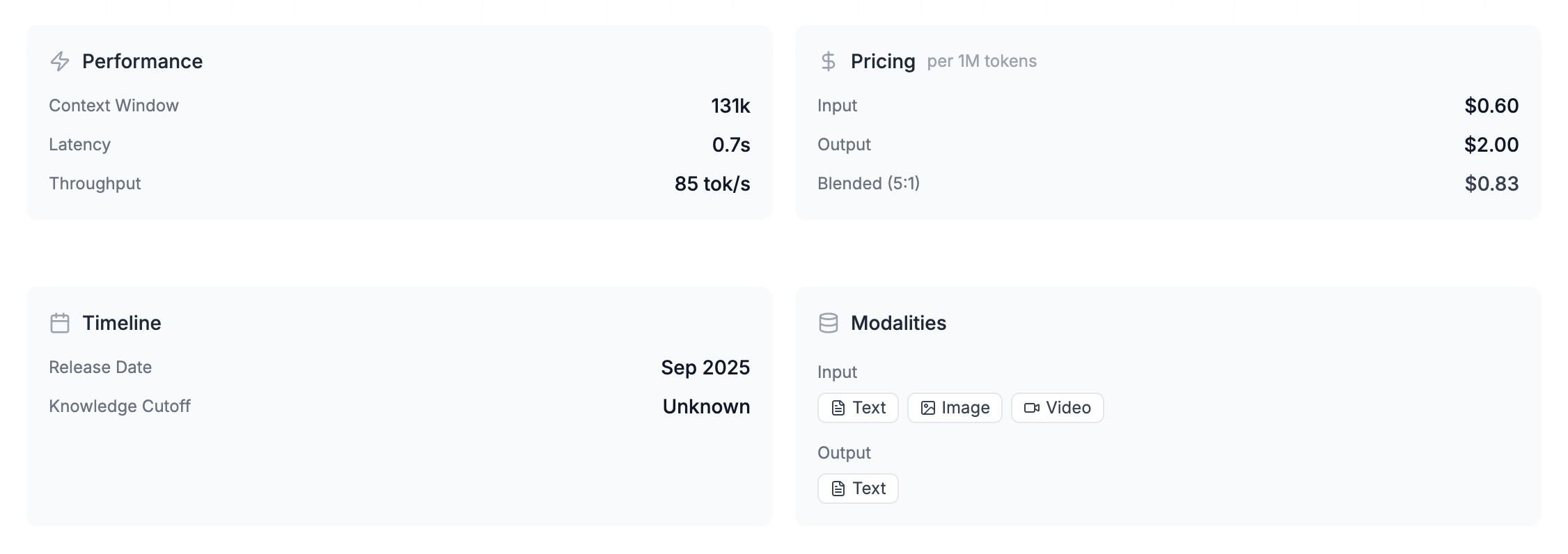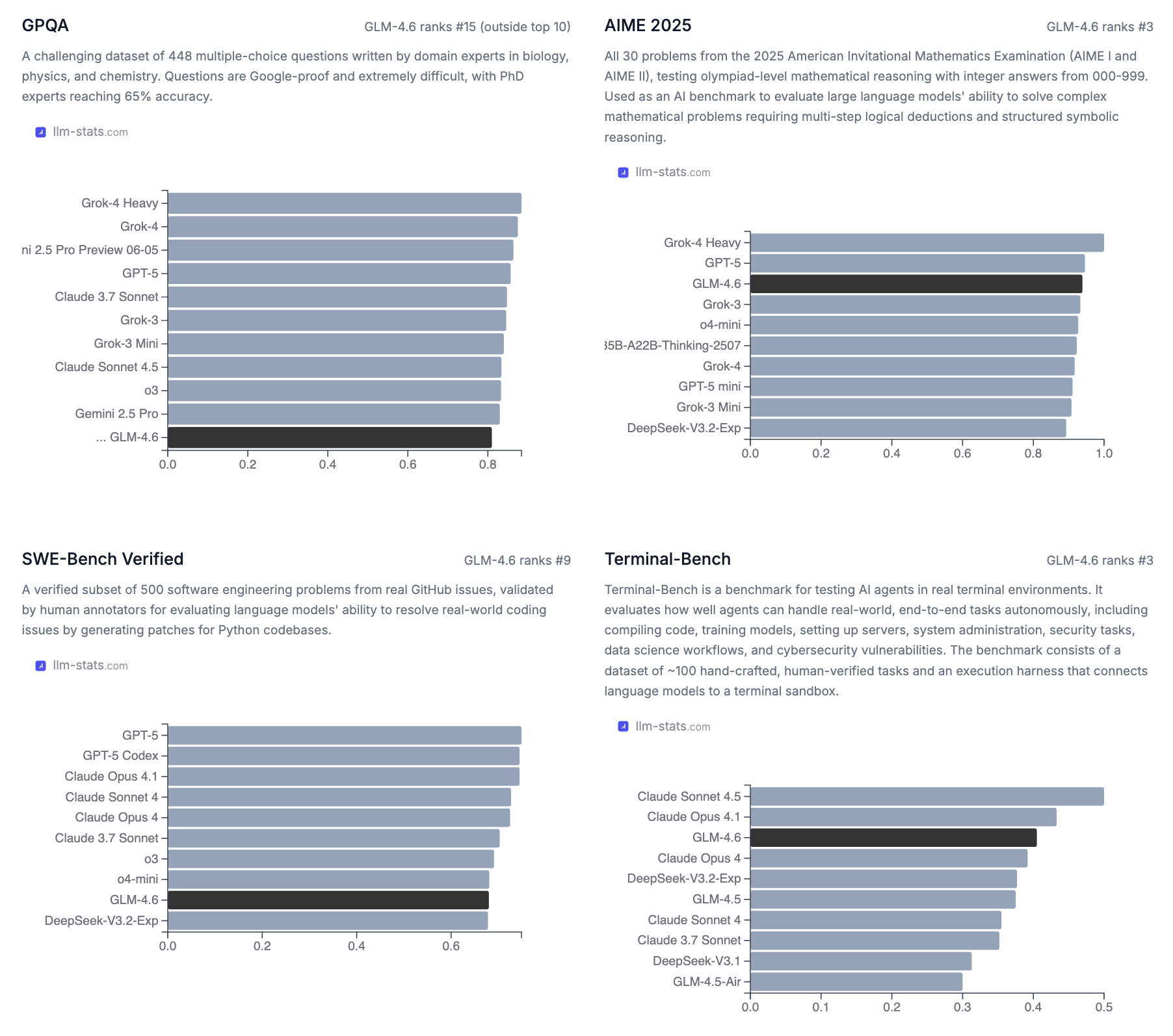
GLM-4.6: Complete Guide, Pricing, Context Window, and API Access
A comprehensive look at GLM-4.6 - Zhipu AI's latest release with 128k context window, agentic capabilities, pricing, API details, benchmarks, and what it means for developers and enterprises.

Introduction: Why GLM-4.6 Is a Milestone
The release of GLM-4.6 marks a pivotal moment in the evolution of open large language models. Announced a few hours ago (Sept 30, 2025), this model is developed by Zhipu AI, a pioneer in China’s AI ecosystem, and made available through both the official launch blog and Hugging Face.
GLM-4.6 builds directly on the successes of GLM-4 and 4.5, introducing improvements in context window, reasoning performance, tool integration, and deployment efficiency. More than just a model update, it represents Zhipu AI’s ambition to make GLM a global competitor to OpenAI’s GPT, Anthropic’s Claude, and Google’s Gemini. With agentic capabilities, larger context windows, and an open-access distribution model, GLM-4.6 is designed for developers, researchers, and enterprises alike.
This release also arrives at a moment when demand for safe, affordable, and enterprise-ready APIs is peaking. Readers looking for information on GLM 4.6 pricing, API access, and the release date will find all of that here, alongside deep insights into performance benchmarks, context window capacity, and real-world applications.
At a Glance: Key Specs & Differentiators
GLM-4.6 offers a blend of open accessibility and enterprise-grade features. Here are its highlights:

- Context Window: Up to 128k tokens (expanded from GLM-4.5)
- Model Size: Trillion-scale parameters (exact numbers undisclosed)
- Release Date: September 30, 2025
- Deployment: Available via Z.ai API and Hugging Face distribution
- Agent Capabilities: Built-in tool use, reasoning chains, and memory modules
- Pricing: Competitive per-token costs (details below)
What sets GLM-4.6 apart is its focus on agent-readiness. Unlike earlier GLM releases, it emphasizes workflow automation, API orchestration, and support for autonomous decision-making, making it a contender for enterprise AI infrastructure.
Architecture & Technical Innovations
GLM-4.6 is built on the General Language Model (GLM) architecture, which has steadily evolved since GLM-130B. While the technical documentation remains partially proprietary, available details highlight several innovations:
- Mixture-of-Experts (MoE) efficiency: Like many frontier models, GLM-4.6 employs selective expert routing, balancing scale with cost efficiency.
- Extended training data: The model benefits from multilingual and multimodal pretraining data, ensuring robustness across domains.
- Inference optimization: Improved parallelism reduces latency, especially in API deployments.
- Agent framework integration: Native support for tool invocation and memory persistence makes it suitable for long-running agent tasks.
Compared to GLM-4.5, GLM-4.6 is faster, more cost-effective at inference, and designed to scale from research use cases to full enterprise production. Its open availability on Hugging Face ensures developers can test and fine-tune locally, while Z.ai’s API provides enterprise support and SLAs.
Extended Context & Memory
One of the most notable upgrades in GLM-4.6 is its 128k token context window. This aligns it with frontier peers like GPT-4o and Claude 4.5 Sonnet, and makes it particularly attractive for:
- Document-heavy tasks: Analyzing long legal contracts, technical manuals, or financial filings.
- Multi-turn conversations: Maintaining coherence across extended dialogues.
- Agent workflows: Storing intermediate reasoning states for decision-making.
In practice, developers can now build applications where the model “remembers” much larger portions of prior interaction without relying solely on external memory modules. This extended window, often searched as “GLM 4.6 context window” or “GLM 4.6 window,” directly addresses one of the most pressing limitations of prior models.
Agentic & Tool-based Capabilities
GLM-4.6 is designed with agents in mind. According to Z.ai, the model:
- Supports structured tool calls: API endpoints, databases, calculators.
- Can handle multi-step reasoning chains: Useful in planning and execution.
- Integrates with external memory systems: Reducing hallucinations in long workflows.
- Enables orchestration across services: Positioning it as a backend for complex AI applications.
These features make it ideal for applications like autonomous research agents, financial analysis copilots, and workflow automation systems. GLM-4.6’s Hugging Face release also ensures developers can experiment with these agentic capabilities in open environments before scaling via the Z.ai API.
Performance Benchmarks & Evaluations
While official benchmarks are still rolling out, early reports suggest GLM-4.6 performs competitively across reasoning, coding, and multilingual tasks.

Key takeaways:
- Reasoning: Upgraded reasoning chain performance puts GLM-4.6 close to DeepSeek V3.2 Exp.
- Coding: Substantial improvement in coding tasks, approaching frontier levels.
- Safety: Refusal handling has improved compared to GLM-4.5, with fewer false positives on benign requests.
GLM-4.6's benchmark profile reveals a clear optimization for practical execution over theoretical knowledge. The model dominates on LiveCodeBench v6 (#1, 82.8%) and HLE (#1), excels at AIME 2025 (#3, 93.9%) and Terminal-Bench (#3, 40.5%), and nearly doubled its predecessor's score on BrowseComp (#4, 45.1). However, it ranks #15 on GPQA, indicating gaps in graduate-level scientific reasoning. This performance pattern suggests GLM-4.6 was purpose-built for agentic workflows, real-world coding, and tool-augmented problem-solving, making it ideal for software development and research automation, though less suited for pure academic applications requiring deep domain expertise in physics, chemistry, or biology.

API, Access & Pricing

See pricing and available providers →
GLM-4.6 is available via the Z.ai API, Hugging Face and LLM Stats.
Safety, Alignment & Bias Mitigations
Safety is a major emphasis for GLM-4.6. Improvements include:
- Bias reduction: In politically sensitive prompts.
- Improved refusal logic: Fewer safe requests incorrectly blocked.
- Robust multi-turn defenses: Better resilience to prompt injection and jailbreak attempts.
- Child and sensitive content handling: Stricter safeguards in high-risk domains.
These changes make it a stronger candidate for enterprise adoption in regulated industries like finance, healthcare, and education.
Implications for Developers & Enterprises
For enterprises, GLM-4.6 provides an attractive balance between open-source accessibility and enterprise-ready support. Potential applications include:
- Knowledge copilots: That ingest entire corporate wikis.
- Customer support automation: With reduced hallucination risks.
- Research assistants: Capable of synthesizing hundreds of pages of technical data.
- Secure workflow automation: Where tool calls must be accurate and safe.
For developers, the availability on Hugging Face lowers the barrier to entry. Teams can test GLM-4.6 locally before transitioning to the API for scale.
Competitive Landscape & Positioning
GLM-4.6 enters a crowded but dynamic field. Compared to its peers:
- Strengths: Open availability, strong context window, agentic readiness, multilingual robustness.
- Weaknesses: Smaller ecosystem compared to OpenAI and Anthropic.
Still, GLM-4.6 offers a rare blend of open accessibility and enterprise-grade performance, making it a unique player in the global LLM race.
TL;DR
GLM-4.6 demonstrates how far Zhipu AI has come in pushing the boundaries of open and enterprise AI. With its expanded context window, improved reasoning performance, and emphasis on agentic capabilities, it is positioned as a competitive alternative to Western frontier models.
Whether you’re curious about GLM 4.6 pricing, want to explore its API, or are following the latest GLM 4.6 news, this release has something for developers, researchers, and businesses alike.
Try GLM-4.6 on Hugging Face or through the Z.ai API.